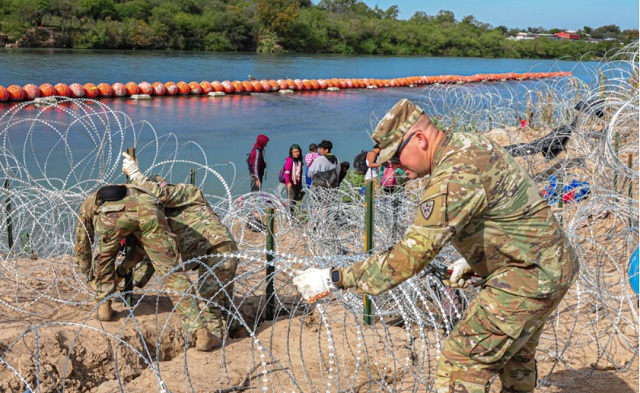illegal immigration
Feds can’t find foreign nationals released into US as terrorism threats heightened

Concertina wire is installed along the banks of the Rio Grande River as part of “Operation Lone Star,” Texas Gov. Greg Abbott’s border security mission.
From The Center Square
By
Nine months after the U.S. Department of Homeland Security Office of Inspector General expressed alarm that under the Biden administration, DHS agencies couldn’t locate where illegal foreign nationals were after they released them into the U.S., ongoing problems persist and terrorism threats are heightened.
Last September, the DHS OIG released a redacted report stating that DHS “does not have assurance that all migrants can be located once they are released into the United States.”
It conducted an audit over a 17-month period when DHS released more than 1.3 million foreign nationals into the U.S. after they illegally entered through the southwest border.
Of the 981,671 Border Patrol records evaluated from March 2021 through August 2022, addresses for more than 177,000 foreign nationals, or nearly 20%, “were either missing, invalid for delivery, or not legitimate residential locations,” it found.
The OIG also found that during this period, Border Patrol agents released 430,000 illegal foreign nationals into the U.S. on their own recognizance with Notice to Appear documents to go before an immigration judge. They released nearly 95,000 with Notice to Report documents to go to an Immigration and Customs Enforcement (ICE) office and more than 318,000 through a new Parole Plus Alternatives to Detention (Parole + ATD) program.
Under the Biden administration, instead of being processed for removal, foreign nationals deemed inadmissible were granted Parole + ATD and released into the U.S. They were also tracked with electronic devices either through wearing ankle bracelets or being given smartphones “intended to ensure compliance with release conditions, court hearings, and final orders of removal,” the report notes.
Prior to releasing them, federal agents are required to vet them to ensure they don’t have a criminal record and aren’t connected to countries of foreign concern or terrorist organizations. Federal agents are also required to obtain an address of where they are going in order to enforce federal immigration law.
The OIG found that DHS agencies had “limited ability” to accurately and effectively track them. Border Patrol “cannot always obtain and does not always record migrant addresses” and ICE “does not always validate migrant addresses prior to their release.”
Border Patrol agents didn’t accurately and effectively capture valid addresses, the report notes, because they were inundated with large influxes of people arriving at the border and because of “limited coordination with ICE and its limited authority to administer compliance with address requirements.” The audit found that “ICE also did not have adequate resources to validate and analyze migrants’ post-release addresses.”
ICE is statutorily required to enforce federal immigration law, specifically detaining and removing inadmissibles. “ICE must be able to locate migrants to enforce immigration laws, including to arrest or remove individuals who are considered potential threats to national security,” the OIG said. “The notable percentage of missing, invalid for delivery, or duplicate addresses on file means DHS may not be able to locate migrants following their release into the United States. As the Department continues to apprehend and release tens of thousands of migrants each month, valid post-release addresses are essential.”
Prior to this audit, the OIG found that DHS processes allowed known or suspected terrorist to illegally enter the U.S. and “potentially threaten national security and public safety.”
The report was released nearly 22 years after the 9/11 terrorist attacks. The terrorist attacks prompted the creation of DHS, consolidating several federal agencies all mandated to protect Americans and prevent another terrorist attack from occurring.
Within the last nine months, the OIG continued to report on DHS failures and authorities nationwide have issued heightened terrorist warnings.
One OIG audit found that U.S. Customs and Border Protection (CBP) and U.S. Citizenship and Immigration Services (USCIS) weren’t effectively screening asylum seekers – meaning they didn’t know who they were releasing into the country.
Another OIG report found that CBP and ICE weren’t detaining and removing inadmissables arriving at a major international airport – with 44% flagged for removal not showing up for their removal flights because federal agents had released them.
Another OIG audit found that DHS, CBP, USCIS and ICE agents didn’t properly vet or resolve derogatory information for tens of thousands of Afghans released into the U.S. After the Biden administration pulled U.S. forces out of Afghanistan in August 2021, 97,000 Afghans were brought to the U.S. Among them, 77,000, or 79%, were granted humanitarian parole into the U.S. allowing them to stay for two years.
The OIG expressed alarm about DHS not having a process “for monitoring parole expiration” after the two-year period ended in August 2023, meaning no plans were in place to remove them.
As numerous officials have warned a terrorist attack on U.S. soil is imminent and members of Congress have demanded answers, an unprecedented estimated 12 million people from over 150 countries have illegally entered the U.S. since the president has been in office.
illegal immigration
US Notes 2.5 million illegals out and counting

President Trump’s Department of Homeland Security is marking what officials are calling a landmark moment in U.S. immigration enforcement, announcing Wednesday that more than 2.5 million illegal aliens have now left the country since Trump returned to the Oval Office in January. DHS Secretary Kristi Noem said the surge reflects a sweeping, sustained crackdown driven by Immigration and Customs Enforcement teams that — according to internal tallies — have already removed more than 605,000 illegal aliens, most of whom were facing criminal charges or carrying prior convictions. Nearly two million more have opted to self-deport, a wave Noem attributes to stepped-up enforcement and the administration’s aggressive public messaging. She again urged those still in the country illegally to use the government’s CBP Home app, which offers a free one-way flight and a $1,000 stipend to expedite departure.
Senior DHS officials say arrests have climbed as well, with almost 600,000 illegal aliens taken into custody since January 20. “Illegal aliens are hearing our message to leave now,” DHS official McLaughlin said this week. “They know if they don’t, we will find them, we will arrest them, and they will never return.”
The administration argues the impact is being felt far beyond immigration courts and detention facilities, pointing to the U.S. housing market as one of the clearest signs of change. For six straight months, DHS says not a single illegal alien has been released into the interior from the southern border — a dramatic shift after years of mass inflows under President Biden. That decline, they say, is finally filtering into rent and home-price data after years of punishing increases.
Housing and Urban Development Secretary Scott Turner said Americans have now seen four consecutive months of rent decreases — the first sustained drop in years — as fewer illegal aliens compete for housing. Vice President JD Vance emphasized the connection even more bluntly: “The connection between illegal immigration and skyrocketing housing costs is as clear as day. We are proud to be moving in the right direction. Still so much to do.”
Research abroad and at home backs up the administration’s argument. Economists in Denmark released findings earlier this year showing that a one-percentage-point rise in local immigration over a five-year period drove private rental prices up roughly 6 percent and home prices up about 11 percent. The Center for Immigration Studies presented similar data to Congress last year, with researcher Steven Camarota testifying that a 5-percentage-point increase in a metro area’s recent-immigrant share was tied to a 12-percent rise in rent for U.S.-born households.
As DHS leaders frame it, Trump’s second-term enforcement machine is reshaping both border policy and household budgets — an approach they say is finally delivering relief to Americans who spent years squeezed by soaring housing costs and unchecked migration.
illegal immigration
EXCLUSIVE: Canadian groups, First Nation police support stronger border security

First Nation police chiefs join Texas Department of Public Safety marine units to patrol the Rio Grande River in Hidalgo County, Texas. L-R: Dwayne Zacharie, President of the First Nations Chiefs of Police Association, Ranatiiostha Swamp, Chief of Police of the Akwesasne Mohawk Territory, Brooks County Sheriff Benny Martinez, Jamie Tronnes, Center for North American Prosperity and Security, Goliad County Sheriff Roy Boyd. Photo: Bethany Blankley for The Center Square
From The Center Square
By
Despite Canadian officials arguing that the “Canada-U.S. border is the best-managed and most secure border in the world,” some Canadian groups and First Nation tribal police chiefs disagree.
This week, First Nation representatives traveled to Texas for the first time in U.S.-Canadian history to find ways to implement stronger border security measures at the U.S.-Canada border, including joining an Operation Lone Start Task Force, The Center Square exclusively reported.
Part of the problem is getting law enforcement, elected officials and the general public to understand the reality that Mexican cartels and transnational criminal organizations are operating in Canada; another stems from Trudeau administration visa policies, they argue.
When it comes to public perception, “If you tell Canadians we have a cartel problem, they’ll laugh at you. They don’t believe it. If you tell them we have a gang problem, they will absolutely agree with you 100%. They don’t think that gangs and cartels are the same thing. They don’t see the Hells Angels as equal to the Sinaloa Cartel because” the biker gang is visible, wearing vests out on the streets and cartel operatives aren’t, Jamie Tronnes, executive director of the Center of North American Prosperity and Security, told The Center Square in an exclusive interview.
The center is a US-based project of the MacDonald-Laurier Institute, the largest think tank in Canada. Tronnes previously served as a special assistant to the cabinet minister responsible for immigration and has a background in counterterrorism. She joined First Nation police chiefs to meet with Texas law enforcement and officials this week.
Another Canadian group, Future Borders Coalition, argues, “Canada has become a critical hub for transnational organized crime, with networks operating through its ports, banks, and border communities.” The Sinaloa and Jalisco New Generation Mexican cartels control the fentanyl, methamphetamine and cocaine business in Canada, partnering with local gangs like the Hells Angels and Chinese Communist Party (CCP)-linked actors, who launder profits through casinos, real estate, and shell companies in Vancouver and Toronto, Ammon Blair, a senior fellow at the Texas Public Policy Foundation, and others said at a coalition event prior to First Nation police chiefs and Tronnes coming to Texas.
“The ’Ndrangheta (Italian Mafia) maintains powerful laundering and import operations in Ontario and Quebec, while MS-13 and similar Central American gangs facilitate human smuggling and enforcement. Financial networks tied to Hezbollah and other Middle Eastern groups support laundering and logistics for these criminal alliances,” the coalition reports.
“Together, they form interconnected, technology-driven enterprises that exploit global shipping, cryptocurrency, and AI-enabled communications to traffic whatever yields profit – narcotics, weapons, tobacco, or people. Taking advantage of Canada’s lenient disclosure laws, fragmented jurisdictions, and weak cross-border coordination, these groups have embedded themselves within legitimate sectors, turning Canada into both a transit corridor and safe haven for organized crime,” the coalition reports.
Some First Nation reservations impacted by transnational crime straddle the U.S.-Canada border. One is the Akwesasne Mohawk Reservation, located in Ontario, Quebec, and in two upstate New York counties, where human smuggling and transnational crime is occurring, The Center Square reported. Another is the Tsawwassen First Nation (TWA) Reservation, located in a coastal region south of Vancouver in British Columbia stretching to Point Roberts in Washington state, which operates a ferry along a major smuggling corridor.
Some First Nation reservations like the TWA are suffering from CCP organized crime, Tronnes said. Coastal residents observe smugglers crossing their back yards, going through the reserve; along Canada’s western border, “a lot of fentanyl is being sent out to Asia but it’s also being made in Canada,” Tronnes said.
Transnational criminal activity went largely unchecked under the Trudeau government, during which “border security, national security and national defense were not primary concerns,” Tronnes told The Center Square. “It’s not to say they weren’t concerns, but they weren’t top of mind concerns. The Trudeau government preferred to focus on things like climate change, international human rights issues, a feminist foreign policy type of situation where they were looking more at virtue signaling rather than securing the country.”
Under the Trudeau administration, the greatest number of illegal border crossers, including Canadians, and the greatest number of known, suspected terrorists (KSTs) were reported at the U.S.-Canada border in U.S. history, The Center Square first reported. They include an Iranian with terrorist ties living in Canada and a Canadian woman who tried to poison President Donald Trump, The Center Square reported.
“Had it been a priority for the government to really crack down and provide resources for national security,” federal, provincial and First Nation law enforcement would be better equipped, funded and staffed, Tronnes said. “They would have better ways to understand what’s really happening at the border.”
In February, President Donald Trump for the first time in U.S. history declared a national emergency at the northern border and ordered U.S. military intervention. Months later, his administration acknowledged the majority of fentanyl and KSTs were coming from Canada, The Center Square reported.
Under a new government and in response to pressure from Trump, Canada proposed a $1.3 billion border plan. However, more is needed, the groups argue, including modernizing border technology and an analytics infrastructure, reforming disclosure and privacy rules to enable intelligence sharing, and recognizing and fully funding First Nation police, designating them as essential services and essential to border security.
“National security doesn’t exist without First Nation policing at the border,” Dwayne Zacharie, First Nations Chiefs of Police president, told The Center Square.
-

 Bruce Dowbiggin2 days ago
Bruce Dowbiggin2 days agoHunting Poilievre Covers For Upcoming Demographic Collapse After Boomers
-

 Business2 days ago
Business2 days agoState of the Canadian Economy: Number of publicly listed companies in Canada down 32.7% since 2010
-

 Censorship Industrial Complex1 day ago
Censorship Industrial Complex1 day agoCanadian university censors free speech advocate who spoke out against Indigenous ‘mass grave’ hoax
-

 Alberta2 days ago
Alberta2 days agoHousing in Calgary and Edmonton remains expensive but more affordable than other cities
-

 Alberta2 days ago
Alberta2 days agoWhat are the odds of a pipeline through the American Pacific Northwest?
-

 Business2 days ago
Business2 days agoWarning Canada: China’s Economic Miracle Was Built on Mass Displacement
-

 Agriculture2 days ago
Agriculture2 days agoThe Climate Argument Against Livestock Doesn’t Add Up
-

 International1 day ago
International1 day agoGeorgia county admits illegally certifying 315k ballots in 2020 presidential election






